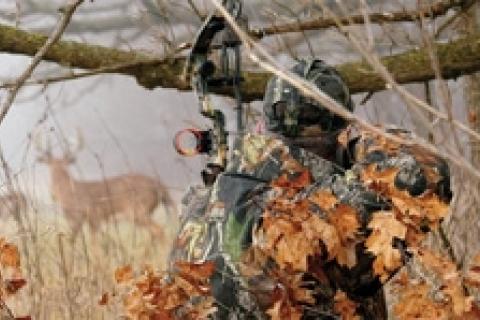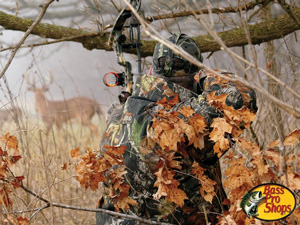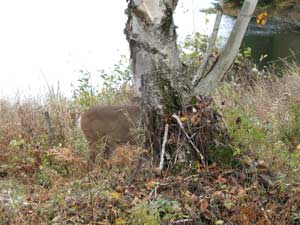

Bowhunting is a straightforward process. You get close to your quarry by stealth or ambush, then you slip an arrow into its vitals before it ever realizes that you were there. After that, you recover the animal and bask in the memories.
That's true, but a new bowhunter needs to know quite a few things before this happens.
Learn to Shoot
First, he or she must become a good archer — if you can't hit your game, the rest hardly matters.
Learn to shoot, preferably under the guidance of a qualified instructor or an experienced mentor. Otherwise, watch videos and read books that detail the finer points of archery. Learn correctly from the start, so you won't have to undo bad habits.
Practice often too. Hone your skills and work out the bugs so that when hunting season finally rolls around none of those shooting gremlins ruin the moment. Shoot from different positions on the ground and from treestands too. Learn to pick a spot on the target; focus, be confident and endeavor to make every shot count.
| Tip: Determine your maximum effective range — the furthest distance that you can consistently hit the kill zone. That's important because it influences how far your stand should be from the ambush point or how close you need to get during a stalk. |
Know Your Game
Study the strengths and weaknesses in the animal you are pursuing. Know its vocalizations and food sources and recognize potential travel routes and bedding areas. Understand rutting and other important behavior; know what the animal's postures, signs and body language means.
You also need to have a sense of how topography, weather and wind direction affect its movement. Lastly, memorize that animal's anatomy, the best shot angles and how to achieve them.
A working knowledge of these things will allow you to make good tactical choices and lethal shots.
Admittedly, it's a lot to know. But, fortunately, a host of hunting books, DVDs and websites provide great information on this.
Tip: It's always best to wait until the near leg of a big game animal is extended forward before sending an arrow into its heart/lung area. This gets all those heavier muscles out of the way and allows for better penetration.
Don't Forget Small Game
Long ago, almost every bowhunter chased small game — for good reason too. This is the surest way to improve your stalking and field shooting skills. Consistently get close enough to take squirrels, grouse or cottontails with a bow and you stand a much better chance when that buck shows.
 |
| Game cameras help the scouting process. |
Just being in the woods and flinging arrows at little critters teaches much aside from how to hit small targets. It shows how far you can shoot before an overhanging branch blocks your arrow's trajectory, the importance of clear shooting lanes and how one little, unseen branch can ruin a shot.
And, of course, it's just plain fun.
Scouting
Scouting shows you how to hunt. It reveals where the animals bed, feed and water as well as the travel routes they take to and from these places. It also tells you whether they're rutting, the prevalent wind directions and other useful information.
When you start, study the hunt area from afar with a set of binoculars. Get an idea of the high percentage areas and times that they are used. Then when you walk the area, go when animal activity is the least, this way you won't disrupt their patterns.
Once there, look for where they feed and trails that enter the area. Any fresh sign you find, like tracks, scat, rubs or scrapes is a good thing, but a mixture of old and new signs is better — that means they use the area routinely and have for some time.
If you find fresh signs, you can commit their locations to memory or mark them down on a map or GPS, if you like. The latter helps you see the big picture better.
In any case, once you've scouted, pick a stand location. This should be overlook areas of high activity or ambush trails leading to them. Scrape lines and feeding areas are two good bets.
| Tip: If you're new to hunting in general, visit the Bass Pro Shops 1Source Hunting Terminology page to get a better understanding on words used in hunting. |
In the Morning, Hunt Closer
In the evening, place your stand so that you can catch animals approaching these areas while there is still light. Typically, with whitetails, this means backtracking the trails that enter the feeding area for a hundred yards or so, towards the bedding area.
Game cameras will definitely help you make stand placement decisions — so use them.
When you choose a stand location, set up within effective range, downwind from the ambush zone.
After that, it's a waiting game. Having said that, don't use the same location too often or you'll contaminate the area with scent and game will pattern you. Set up several sites for two or three different wind directions at each location.
If you decide to stalk game with a bow, good luck. It's difficult, but doable. Aside from the obvious need for stealth, you should also hunt upwind or crosswind towards high percentage spots. In these situations, I stalk and call a lot.
The Right Shot
 |
| Now would be a good time to come to a full draw. |
Hopefully, this preparation will get you a shot. What newbies forget is that the ability to come to full draw without being detected is just as important as accuracy — without this, there's no shot. This means picking the right moment to move — when a turkey's head is behind its fanned tail or when a deer is behind a tree, for instance.
Also, the hunter needs to remain calm and pick a small spot over the vitals to aim at, rather than look at the whole animal or the beard or antlers. It takes patience to wait for the right opportunity and discipline to sometimes pass up marginal chances, but the end result is worth it.
After the Shot
Lastly, a new bowhunter needs to remain calm after the shot, too. Replay the details in your mind. Where did the arrow hit? How did the animal react? A heart shot animal will typically jump straight up, while a gut shot will often leave them hunched over, for instance.
Often, you'll see the animal fall, but sometimes you won't. That's when you need to mark the last place you saw it.
Then wait, 20 minutes minimum, if you know it was a good hit in the lungs or heart. A gut shot animal requires hours (unless weather threatens to wipe out the trail or predators like wolves are nearby). Follow the tracks and blood sign; don't abandon the last sign until you've found the next. Mark each with flagging tape and watch ahead for the animal. Also check to your flanks and rear occasionally in case it circles back.
Eventually, if it was hit right, you'll find it. If you lose the trail, do a grid search until you find it. Never give up until you have exhausted all options and know that a well-hit animal rarely goes too far, if it isn't pushed.
In the end, you'll have something to be proud of: an animal taken fairly with a bow. But that's also when the work begins. The good news is to a new bowhunter, hauling out a first kill hardly seems like work at all.
- 11253 views

